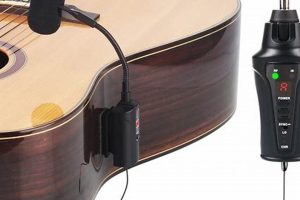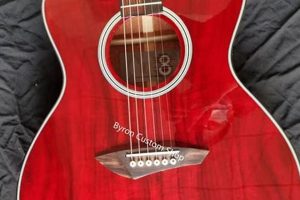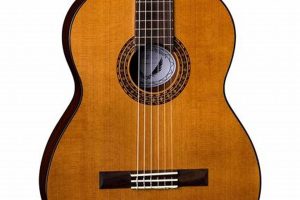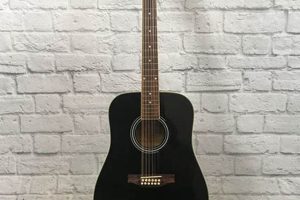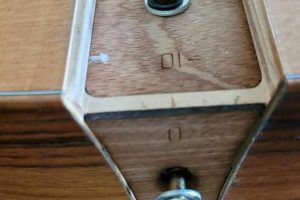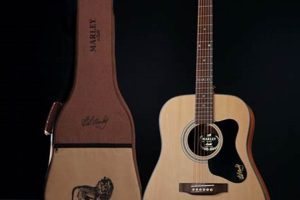When it comes to musical instruments, the acoustic guitar stands out as a timeless classic. Its captivating sound and versatility have made it a staple in various genres of music. Understanding the different parts of an acoustic guitar is essential for both players and enthusiasts.
Editor’s Note: Understanding the parts of an acoustic guitar is crucial for several reasons. It enables players to make informed decisions when choosing and maintaining their instrument. Moreover, it enhances their appreciation for the craftsmanship and design that goes into creating these beautiful instruments.
Through careful analysis and research, we have compiled this comprehensive guide to the parts of an acoustic guitar. Our goal is to empower you with the knowledge to make informed choices and deepen your understanding of this iconic instrument.
Key Differences: Acoustic vs. Electric Guitars
| Feature | Acoustic Guitar | Electric Guitar |
|---|---|---|
| Body | Hollow or semi-hollow body that resonates to produce sound | Solid body that does not resonate significantly |
| Strings | Typically nylon or steel strings | Metal strings |
| Pickups | No pickups (relies on natural resonance) | Pickups convert string vibrations into electrical signals |
Main Article Topics
- Body
- Neck
- Headstock
- Bridge
- Soundhole
- Tuning Pegs
- Frets
- Pickguard
1. Body
The body of an acoustic guitar is its central component, responsible for resonating and amplifying the sound produced by the strings. Its shape, size, and construction significantly influence the overall tone and volume of the instrument.
- Soundboard: The top of the guitar’s body, made from thin, resonant wood, vibrates to produce sound.
- Back and Sides: The back and sides of the body contribute to the guitar’s resonance and sustain.
- Bracing: Internal supports within the body that enhance its strength and resonance.
- Soundhole: The opening in the soundboard that allows sound to escape and project outward.
The body’s size and shape affect the guitar’s overall tone and volume. Larger bodies produce a louder and more resonant sound, while smaller bodies produce a more focused and intimate tone. The choice of wood used for the body also influences the sound, with different woods imparting their own unique tonal characteristics.
The body of an acoustic guitar is a complex and delicate component that requires careful craftsmanship to produce the desired sound and playability. Understanding the different parts of the body and their functions is essential for appreciating the art and science behind these beautiful instruments.
2. Neck
The neck of an acoustic guitar plays a crucial role in the instrument’s overall playability, sound, and structural integrity. As the primary connection between the body and the headstock, it serves several important functions.
Firstly, the neck provides a stable platform for the strings, allowing the player to fret notes accurately and comfortably. Its length and width determine the scale length of the guitar, which influences the string tension and overall tone. The neck’s shape and profile also affect the playing feel and hand position.
Secondly, the neck contributes to the guitar’s sound by transmitting vibrations from the strings to the body. The type of wood used for the neck, as well as its construction and bracing, can influence the guitar’s tonal characteristics.
Understanding the role of the neck in the context of the entire guitar is essential for players and enthusiasts alike. It enables them to make informed decisions when choosing and maintaining their instrument, and to appreciate the craftsmanship and design that goes into creating these beautiful and versatile instruments.
Key Insights:
- The neck is a crucial component of an acoustic guitar, connecting the body to the headstock and providing support for the strings.
- The neck’s length, width, shape, and construction influence the guitar’s playability, sound, and structural integrity.
- Understanding the role of the neck is essential for players and enthusiasts to make informed decisions about their instrument.
3. Headstock
The headstock of an acoustic guitar is an integral part of the instrument, responsible for housing the tuning pegs and maintaining the tension of the strings. Its design and construction directly influence the guitar’s playability, tuning stability, and overall appearance.
- Tuning Stability: The headstock’s shape and angle affect the break angle of the strings over the nut. A proper break angle ensures that the strings stay in tune better and reduces string slippage.
- String Tension: The tuning pegs located on the headstock allow players to adjust the tension of the strings, which affects the pitch and tone of the guitar.
- Balance and Aesthetics: The headstock contributes to the guitar’s overall balance and visual appeal. Different headstock designs, such as slotted or solid headstocks, can enhance the instrument’s aesthetics.
Understanding the role of the headstock in relation to the other parts of an acoustic guitar is essential for players and enthusiasts alike. It enables them to make informed decisions when choosing and maintaining their instrument, and to appreciate the craftsmanship and design that goes into creating these beautiful and versatile instruments.
4. Bridge
The bridge of an acoustic guitar is a crucial component that plays a vital role in transferring string vibrations to the body and enabling intonation adjustment. Its design and construction directly influence the instrument’s sound, playability, and overall performance.
- Sound Transmission: The bridge is responsible for transferring the vibrations of the strings to the soundboard, which amplifies and resonates the sound. The saddle, a small piece located on the bridge, plays a key role in this process.
- Intonation Adjustment: The bridge allows for intonation adjustment, ensuring that each string plays in tune a
t different frets. This is achieved by adjusting the length of the string from the bridge to the nut, which affects the string’s tension and pitch. - String Spacing: The bridge determines the spacing between the strings, which affects the playability and comfort for the guitarist. Wider string spacing can provide more room for fingerpicking, while narrower spacing may be preferred for strumming.
- Structural Support: The bridge provides structural support to the guitar’s body, helping to maintain the instrument’s shape and integrity.
Understanding the bridge’s role in relation to the other parts of an acoustic guitar is essential for players and enthusiasts alike. It enables them to make informed decisions when choosing and maintaining their instrument, and to appreciate the craftsmanship and design that goes into creating these beautiful and versatile instruments.
5. Soundhole
The soundhole of an acoustic guitar is a crucial component that plays a vital role in shaping the instrument’s sound. It acts as an acoustic outlet, allowing sound waves generated by the vibrating strings to escape from the body and project outward.
- Tonal Impact: The size, shape, and placement of the soundhole significantly influence the guitar’s overall tone. Larger soundholes tend to produce a louder and more resonant sound, while smaller soundholes offer a more focused and controlled tone.
- Volume Projection: The soundhole acts as a natural amplifier, projecting the sound of the guitar outward. The position and size of the soundhole affect the direction and dispersion of the sound, influencing the instrument’s projection and clarity.
- Aesthetic Element: The soundhole is often adorned with decorative elements, such as rosettes or purfling, contributing to the guitar’s visual appeal.
Understanding the role of the soundhole in relation to the other parts of an acoustic guitar is essential for players and enthusiasts alike. It enables them to appreciate the intricate interplay between different components and their combined effect on the instrument’s sound and appearance.
6. Tuning Pegs
Tuning pegs are an essential component of an acoustic guitar, playing a crucial role in ensuring the instrument’s intonation and playability. These pegs are typically located on the headstock of the guitar and are used to adjust the tension of the strings, thereby altering their pitch.
The accurate tuning of an acoustic guitar is paramount for producing harmonious and pleasing sounds. Tuning pegs allow guitarists to fine-tune each string to a specific pitch, enabling them to play in tune with other instruments or backing tracks. Proper tuning also ensures that the guitar’s frets are correctly intonated, meaning that each fret produces the correct note when pressed.
The use of tuning pegs involves turning them clockwise to tighten the strings and increase their pitch, or counterclockwise to loosen the strings and decrease their pitch. It is important to note that over-tightening the strings can damage them or cause the guitar’s neck to warp, so it is always advisable to tune carefully and gradually.
Tuning pegs come in various designs and materials, such as plastic, metal, or wood. The choice of material can affect the tuning stability and overall feel of the guitar. Some tuning pegs incorporate gear mechanisms for smoother and more precise adjustments.
In conclusion, tuning pegs are an indispensable part of an acoustic guitar, enabling guitarists to adjust the pitch of the strings and achieve accurate intonation. Understanding the role and proper use of tuning pegs is crucial for maintaining the instrument’s playability and ensuring a harmonious musical experience.
Key Insights:
- Tuning pegs are used to adjust the pitch of the strings on an acoustic guitar.
- Accurate tuning is essential for intonation and playing in tune with other instruments.
- Tuning pegs come in various designs and materials, affecting tuning stability and feel.
- Proper use of tuning pegs involves gradual adjustments to avoid damage to the strings or guitar.
7. Frets
Frets are an essential component of an acoustic guitar, playing a crucial role in producing clear and accurate notes across the entire length of the neck. These thin, metal bars are precisely positioned at specific intervals along the fingerboard, dividing the strings into different note divisions.
The accurate placement of frets is critical for intonation, ensuring that each fretted note is in tune with its corresponding open string. This precise fretting allows guitarists to play chords and melodies with consistent intonation, enhancing the overall sound and playability of the instrument.
Frets are typically made of durable metals such as nickel, stainless steel, or brass, which can withstand the wear and tear of frequent playing. The choice of fret material can affect the tone and feel of the guitar, with different metals offering unique sonic characteristics.
Understanding the role and proper use of frets is essential for guitarists of all levels. By fretting the strings correctly, guitarists can achieve clear and accurate notes, expand their playing range, and explore various musical techniques.
Key Insights:
- Frets are essential for dividing the strings into different notes, enabling guitarists to play chords and melodies with accurate intonation.
- Proper fretting technique is crucial for achieving clear and accurate notes, enhancing the overall sound and playability of the guitar.
- Frets are typically made of durable metals, with the choice of material affecting the tone and feel of the instrument.
8. Pickguard
The pickguard, an essential component of an acoustic guitar, plays a crucial role in preserving the instrument’s pristine finish and enhancing its durability. As its name suggests, the pickguard acts as a protective barrier between the guitar’s body and the pick, safeguarding it from scratches and dings that can occur during strumming.
When strumming the guitar, the pick repeatedly brushes against the body, creating friction that can damage the delicate finish over time. The pickguard, strategically placed over the area where the pick makes contact, absorbs this friction and prevents the guitar’s body from being marred. This protective layer ensures that the guitar retains its aesthetic appeal and resale value, even with regular use.
Moreover, the pickguard’s presence contributes to the overall structural integrity of the guitar. By preventing scratches and dents, the pickguard helps maintain the body’s smooth surface, reducing the likelihood of cracks or other damage that could compromise the instrument’s sound quality and playability.
In addition to its protective and structural benefits, the pickguard also serves as a decorative element, adding a touch of style and pers
onalization to the guitar. Pickguards come in various shapes, sizes, and materials, allowing guitarists to customize their instruments and express their individual tastes.
Understanding the role and significance of the pickguard as a component of an acoustic guitar is essential for guitarists of all levels. By recognizing its protective and aesthetic value, guitarists can make informed decisions when choosing and maintaining their instruments, ensuring their longevity and enjoyment.
Key Insights:
- The pickguard protects the guitar’s body from scratches caused by strumming, preserving its finish and value.
- The pickguard contributes to the guitar’s structural integrity by preventing damage that could affect sound quality and playability.
- Pickguards come in various designs and materials, allowing guitarists to customize their instruments and express their personal style.
9. Strings
Strings are an integral part of an acoustic guitar, responsible for producing the instrument’s characteristic sound. These strings, made from either nylon or steel, vibrate when plucked or strummed, generating the acoustic waves that resonate within the guitar’s body.
- Material and Sound: The material of the strings significantly influences the guitar’s tone and feel. Nylon strings, commonly found on classical guitars, produce a warmer, softer sound with less projection compared to steel strings. Steel strings, used on most other acoustic guitars, offer a brighter, more resonant sound with greater volume.
- Tension and Playability: The tension of the strings affects the guitar’s playability and overall sound. Steel strings typically have higher tension than nylon strings, requiring more finger strength to press down. This higher tension also contributes to the brighter, louder sound of steel-string guitars.
- String Gauge: The gauge, or thickness, of the strings impacts the guitar’s tone and feel. Thicker strings produce a fuller, warmer sound but can be more challenging to play. Conversely, thinner strings offer a brighter, more articulate sound but may require less finger strength.
- String Arrangement: Acoustic guitars typically have six strings arranged in standard tuning. However, various tunings and alternative string arrangements exist, allowing guitarists to explore different sounds and playing styles.
Understanding the role and characteristics of strings is essential for guitarists of all levels. By selecting the appropriate strings based on material, tension, gauge, and arrangement, guitarists can tailor their instrument’s sound and playability to suit their individual preferences and musical genres.
10. Bracing
Bracing plays a crucial role within the internal structure of an acoustic guitar, contributing significantly to its strength and resonance. These internal supports, typically made of wood, are strategically placed inside the guitar’s body to reinforce its structure and enhance its acoustic properties.
The bracing pattern and design vary depending on the guitar’s size, shape, and tonal goals. Common bracing patterns include:
- X-bracing: A popular and traditional bracing pattern, the X-bracing consists of two X-shaped braces that extend from the bridge to the soundhole, providing structural support and enhancing the guitar’s resonance.
- A-bracing: Another common bracing pattern, the A-bracing features two A-shaped braces that extend from the bridge to the soundhole, offering a brighter and more balanced tone.
- Scalloped bracing: A more modern bracing pattern, the scalloped bracing involves thinning or scalloping the braces, resulting in a lighter and more responsive guitar with increased volume and sustain.
The bracing system works in conjunction with the guitar’s body, soundboard, and back to create a resonant chamber that amplifies the vibrations of the strings. Proper bracing ensures that the guitar’s top and back can vibrate freely, producing a rich and full sound. It also prevents the guitar from collapsing under the tension of the strings, maintaining its structural integrity and playability.
Understanding the importance of bracing as a component of an acoustic guitar is essential for appreciating the instrument’s craftsmanship and tonal qualities. The bracing system contributes to the guitar’s overall sound, strength, and longevity, making it an indispensable part of the instrument’s design and construction.
Key Insights:
- Bracing provides structural support and enhances the resonance of an acoustic guitar.
- Different bracing patterns, such as X-bracing and A-bracing, impact the guitar’s tone and volume.
- Proper bracing ensures the guitar’s top and back can vibrate freely, producing a rich and full sound.
- Understanding the role of bracing is crucial for appreciating the craftsmanship and tonal qualities of an acoustic guitar.
FAQs
This section addresses frequently asked questions to provide a comprehensive understanding of the various parts of an acoustic guitar:
Question 1: What are the main parts of an acoustic guitar?
An acoustic guitar comprises several essential parts, including the body, neck, headstock, bridge, soundhole, tuning pegs, frets, pickguard, strings, and bracing.
Question 2: What is the function of the guitar’s body?
The body of the guitar acts as a resonant chamber, amplifying the sound produced by the vibrating strings. It consists of the soundboard, back, and sides, each contributing to the guitar’s tonal characteristics.
Question 3: What is the purpose of the neck on a guitar?
The neck provides support for the strings and enables fretting. It connects the body to the headstock, where the tuning pegs are located. The neck’s shape and construction influence the guitar’s playability and overall feel.
Question 4: What is the role of the bridge in an acoustic guitar?
The bridge transfers the vibrations of the strings to the body, contributing to the guitar’s sound and intonation. It also allows for string height and intonation adjustments to ensure accurate tuning.
Question 5: What is the importance of the soundhole in an acoustic guitar?
The soundhole allows sound waves generated by the vibrating strings to escape from the body, projecting the guitar’s sound outward. Its size and placement affect the instrument’s volume and tonal response.
Question 6: What is the function of frets on a guitar?
Frets are metal bars embedded into the guitar’s neck, dividing the strings into specific note divisions. They enable guitarists to play notes accurately by pressing the strings down at the desired fret.
Summary: Understanding the parts of an acoustic guitar and their respective functions is essential for players and enthusiasts alike. Each component contributes to the instrument’s sound, playability, and overall quality.
Transition: This comprehensive guide to the parts of an acoustic guitar serves as a valuable resource for anyone seeking to deepen their knowledge of this iconic instrument.
Tips for Understanding the Parts of an Acoustic Guitar
Understanding the components of an acoustic guitar is crucial for players and enthusiasts. Here are some tips to enhance your knowledge and appreciation of this instrument:
Tip 1: Study the Anatomy of the Guitar: Familiarize yourself with the guitar’s main parts, including the body, neck, headstock, bridge, soundhole, tuning pegs, frets, pickguard, strings, and bracing. Each component plays a specific role in the instrument’s sound, playability, and overall quality.
Tip 2: Explore Different Body Shapes and Sizes: Acoustic guitars come in various body shapes and sizes, each influencing the instrument’s tone and volume. Experiment with different body styles, such as dreadnought, jumbo, and parlor guitars, to find the one that best suits your musical preferences.
Tip 3: Pay Attention to the Neck Profile: The neck’s shape and profile significantly impact the guitar’s playability. Consider the thickness, width, and curvature of the neck to determine which feels most comfortable and facilitates your playing style.
Tip 4: Understand the Importance of Bracing: The bracing pattern inside the guitar’s body contributes to its structural integrity and tonal qualities. Different bracing patterns, such as X-bracing and A-bracing, affect the guitar’s sound and responsiveness.
Tip 5: Choose the Right Strings: The type of strings you use can significantly alter the guitar’s sound and feel. Nylon strings produce a warmer, softer tone, while steel strings offer a brighter, more resonant sound. Experiment with different string gauges and materials to find the combination that complements your playing style.
Summary: By following these tips, you can gain a comprehensive understanding of the parts of an acoustic guitar and appreciate the intricate interplay between these components. This knowledge will enhance your playing experience and enable you to make informed decisions when choosing and maintaining your instrument.
Transition to Conclusion: With a deeper understanding of the various parts of an acoustic guitar, you can unlock the full potential of this versatile and expressive instrument.
Conclusion
Through an in-depth exploration of the parts of an acoustic guitar, we have gained a profound appreciation for the intricate interplay of its components. From the resonant body to the precise intonation provided by the bridge, each part contributes to the instrument’s captivating sound and playability.
Understanding the anatomy of an acoustic guitar empowers players and enthusiasts alike. It enables informed decision-making when choosing and maintaining an instrument that aligns with their musical aspirations. Moreover, it fosters a deeper appreciation for the craftsmanship and innovation that goes into creating these timeless pieces.
As you continue your musical journey, may this newfound knowledge serve as a guide, unlocking the full potential of your acoustic guitar. Embrace the symphony of sound that awaits, and let the music flow through you.
Youtube Video:



